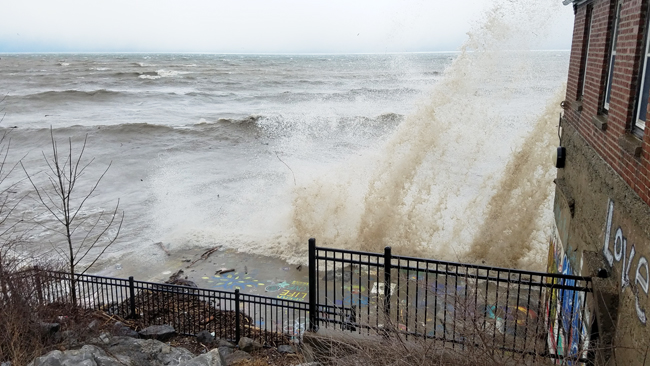Learn How to Be Ready for Seiche Season on Lake Erie — October 17 Information Meeting in Evans
Five of Top 10 recorded Lake Erie seiches near Buffalo have occurred since 2019
Contact:
Roy Widrig, NYSG Great Lakes Coastal Processes and Hazards Specialist, E: rlw294@cornell.edu, P: (315) 234-1916
Kara Lynn Dunn, NYSG's Freelance Great Lakes Publicist, E: karalynn@gisco.net, P: (315) 465-7578
Angola, NY, September 25, 2024 - On October 17, 2024, New York Sea Grant, the Lake Erie Watershed Protection Alliance of Cattaraugus, Chautauqua and Erie counties, and the Town of Evans will host an informational meeting to help shoreline property owners, municipal leaders, and natural resource managers be better prepared to deal with the potential for seiche-caused coastal flooding and property damage.
• The meeting will be held from 6:00 p.m. to 8:00 p.m. at the Lake Erie Beach Volunteer Fire Hall, 9483 Lake Shore Road, in Angola, New York.
• There is no cost to attend the October 17 program; however, registration for seating is encouraged at https://bit.ly/shorelinepreparednessworkshop1024 or call 315-312-3042 for more information.
• The New York State Department of Environmental Conservation Great Lakes Program has provided funding support for this workshop.
Five of the top 10 recorded Lake Erie seiches near Buffalo have occurred since 2019 (National Oceanic and Atmospheric Administration data). Lake Erie, the shallowest of the Great Lakes with its west-east positioning, is conducive to the development of seiches – standing waves that impact the western New York shoreline with significant force. Seiche events have become more common on Lake Erie with decreased winter ice conditions and more severe wind events during the winter season.
New York Sea Grant Coastal Processes and Hazards Specialist Roy Widrig, co-author of a “Seiche Events on Lake Erie” Fact Sheet, will host the meeting. National Weather Service: Buffalo Meteorologist (retired) Judith Levan and Widrig will be among the speakers presenting information on seiche forecasting, shoreline changes from seiche events, and how to manage shoreline erosion and flooding.
Additionally, Widrig offers virtual and in-person assistance (upon request) with evaluating a waterfront area for erosion problems. Property owners and managers of shoreline areas along New York’s Great Lakes-St. Lawrence River shoreline may request this assistance via NYSG's Virtual Site Visit Portal at www.nyseagrant.org/glcoastalvirtualsitevisit.
The “Learn How to Be Ready for Seiche Season on Lake Erie” Workshop and site erosion evaluation assistance are offered as free educational services of NYSG.

A seiche wave impacts a building in Buffalo, NY. Credit: NYS Department of Environmental Conservation
More Information
• During seiche events on Lake Erie, wind “piles up” water on the lake’s eastern shore from Pennsylvania to Buffalo, while water levels near Toledo and Sandusky, Ohio, are pulled down.
• The November 1, 2019 seiche event on Lake Erie caused 12-foot waves, widespread flooding and coastal erosion along the northwest Pennsylvania and southwestern New York shorelines.
• In October 1844, a 22-foot seiche breached the 14-foot seawall at Buffalo; 78 people drowned in that event.
• In March 1848, seiche-induced ice damming in the Niagara River caused Niagara Falls to stop flowing for almost 30 hours.
More Info: New York Sea Grant
New York Sea Grant (NYSG), a cooperative program of Cornell University
and the State University of New York (SUNY), is one of 34 university-based
programs under the National Oceanic and Atmospheric Administration’s
National Sea Grant College Program.
Since 1971, NYSG has represented a statewide network of integrated
research, education and extension services promoting coastal community
economic vitality, environmental sustainability and citizen awareness
and understanding about the State’s marine and Great Lakes resources.
Through NYSG’s efforts, the combined talents of university scientists
and extension specialists help develop and transfer science-based
information to many coastal user groups—businesses and industries,
federal, state and local government decision-makers and agency managers,
educators, the media and the interested public.
The program maintains Great Lakes offices at Cornell University, SUNY
Buffalo, Rochester Institute of Technology, SUNY Oswego, the Wayne County Cooperative Extension office
in Newark, and in Watertown. In the State's marine waters, NYSG has offices at Stony Brook
University and with Cornell Cooperative Extension of Nassau County on Long Island, in Queens, at Brooklyn College, with Cornell Cooperative
Extension in NYC, in Bronx, with Cornell Cooperative Extension of Ulster County in Kingston, and with Cornell Cooperative Extension of Westchester County in Elmsford.
For updates on Sea Grant activities: www.nyseagrant.org has Facebook, Twitter/X, Instagram, and YouTube links. NYSG offers a free e-list sign up via www.nyseagrant.org/nycoastlines for its flagship publication, NY Coastlines/Currents, which is published quarterly.